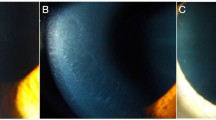Abstract
Purpose
To characterize the clinical presentation of posterior polymorphous corneal dystrophy (PPCD) in eyes of Indian ethnicity.
Design
Retrospective cohort study from January 1995 to December 2015.
Participants
Patients with the diagnosis of posterior polymorphous corneal dystrophy.
Methods
Medical records of the patients were reviewed for clinical presentation. Histology of corneal specimens of those that underwent keratoplasty was assessed.
Main outcome measures
Descriptive analysis of clinical condition.
Results
Mean age at first evaluation was 32.5 years (range 1–73 years), male:female = 35:18. Majority (44/53; 83 %) of the patients had bilateral involvement. 5/9 (44 %) patients with unilateral presentation were amblyopic in the affected eye. The clinical features documented were vesicles in 94 eyes, band-like pattern in 32 eyes, edema of varying degree in 23 eyes (12 patients, 1 patient was one eyed), and anterior segment changes in 1 eye. 8/45 (17 %) eyes had a regular astigmatism with steep axis >47 D (range 47.2–56.2 D). 16 eyes of 12 patients who had clinically evident corneal edema underwent keratoplasty. Mean age at keratoplasty was 58 years (range 1–73 years). 8 patients had penetrating keratoplasty (PK) and 8 had Descemet stripping endothelial keratoplasty (DSEK). Mean follow-up after keratoplasty was 4.2 years (1 month to 13 years). Except one, all grafts remained clear till the last follow-up. In all specimens, the Descemet membrane was grossly thickened.
Conclusions
In our study, 12/53 (22.6 %) patients required keratoplasty for visually significant corneal edema. Except one, all were older adults. The patients who needed keratoplasty were bilaterally afflicted and had visually significant cornea edema in both eyes. With a mean follow-up duration of 4.2 years after keratoplasty, no recurrences were noted.



Similar content being viewed by others
References
Cibis GW, Krachmer JA, Phelps CD, Weingeist TA (1977) The clinical spectrum of posterior polymorphous dystrophy. Arch Ophthalmol 95(9):1529–1537
Heon E et al (1995) Linkage of posterior polymorphous corneal dystrophy to 20q11. Hum Mol Genet 4(3):485–488
Biswas S et al (2001) Missense mutations in COL8A2, the gene encoding the alpha2 chain of type VIII collagen, cause two forms of corneal endothelial dystrophy. Hum Mol Genet 10(21):2415–2423
Shimizu S et al (2004) A locus for posterior polymorphous corneal dystrophy (PPCD3) maps to chromosome10. Am J Med Genet A 130A(4):372–377
Liskova P, Gwilliam R, Filipec M, Jirsova K, Reinstein Merjava S, Deloukas P et al (2012) High prevalence of posterior polymorphous corneal dystrophy in the Czech Republic; linkage disequilibrium mapping and dating an ancestral mutation. PLoS One 7(9):e45495
Aldave AJ, Ann LB, Frausto RF et al (2013) Classification of posterior polymorphous corneal dystrophy as a corneal ectatic disorder following confirmation of associated significant corneal steepening. JAMA Ophthalmol 131(12):1583–1590
Shen J, Chixin D, Gu Y (2015) Long-term observation of coexistence of posterior polymorphous corneal dystrophy, resultant high myopia and nonkeratoconic developing corneal astigmatism: a case report of 7-year tracking in a Chinese boy. Medicine (Baltimore) 94(23):e921
Teekhasaenee C, Nimmanit S, Wutthiphan S, Vareesangthip K, Laohapand T, Malasitr P, Ritch R (1991) Posterior polymorphous dystrophy and Alport syndrome. Ophthalmology 98(8):1207–1215
Sella R, Rootman D, Bahar I (2013) Descemet’s stripping automated endothelial keratoplasty for posterior polymorphous corneal dystrophy in an 8-month-old boy. J AAPOS 17(1):94–96
Krachmer JH (1985) Posterior polymorphous corneal dystrophy: a disease characterized by epithelial-like endothelial cells which influence management and prognosis. Trans Am Ophthalmol Soc 83:413–475
DeRespinis PA, Norden RA, Rispoli LC (1996) Posterior polymorphous dystrophy associated with astigmatism and amblyopia in children. J Refract Surg 12(6):709–714
Bozkurt B, Ozkan F, Yilmaz M, Okudan S (2015) Posterior corneal steepening in posterior polymorphous corneal dystrophy. Optom Vis Sci 92(11):414–419
Raber IM, Fintelmann R, Chhabra S, Ribeiro MP, Eagle RC Jr, Orlin SE (2011) Posterior polymorphous dystrophy associated with non-keratoconic steep corneal curvatures. Cornea 30(10):1120–1124
Pang CJ, Jing Y, Li J, Song XH, Wang LY (2011) Clinical observation of posterior polymorphous corneal dystrophy. Zhonghua Yan Ke Za Zhi 47(1):17–21
Jang MS, Roldan AN, Frausto RF, Aldave AJ (2014) Posterior polymorphous corneal dystrophy 3 is associated with agenesis and hypoplasia of the corpus callosum. Vis Res 100:88–92
Nguyen DQ, Hosseini M, Billingsley G, Héon E, Churchill AJ (2010) Clinical phenotype of posterior polymorphous corneal dystrophy in a family with a novel ZEB1 mutation. Acta Ophthalmol 88(6):695–699
Acknowledgments
We would like to thank Dr. Dilip Kumar Mishra, Mr. Sridhar Rao, and Mr. Naidu from the Ocular Pathology Services, LV Prasad Eye Institute for providing histology support.
Author's Contribution
Design and conduct of the study: SCH; collection, management, analysis, and interpretation of the data: SCH, RM, BG; preparation of the manuscript: SCH; review of the manuscript: SCH, MDR; final approval of the manuscript: SCH, MDR, RM, BG, DM, SIM.
Author information
Authors and Affiliations
Corresponding author
Ethics declarations
Conflict of interests
None.
Rights and permissions
About this article
Cite this article
Chaurasia, S., Mittal, R., Bichappa, G. et al. Clinical characterization of posterior polymorphous corneal dystrophy in patients of Indian ethnicity. Int Ophthalmol 37, 945–952 (2017). https://doi.org/10.1007/s10792-016-0360-y
Received:
Accepted:
Published:
Issue Date:
DOI: https://doi.org/10.1007/s10792-016-0360-y




